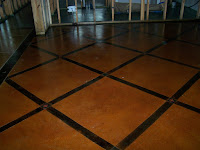Swallowing the $400 Billion "Emergency Economic Stabilization Act of 2008" last week was a little bit like swallowing a brick. I'll let the economists debate the virtues of that package, but the upside of the legislation was found in Division B of H.R. 1424, the "Energy Improvement and Extension Act of 2008."
We started the planning for our energy-efficient home in 2007. At the time there were several federal tax-credits on the books for energy-efficient construction and modifications. Let me be clear with this statement, we would have made the decision to build efficiently whether we were getting tax credits or not, however: 1) they do help offset the upfront costs of our more expensive, but more energy efficient choices and 2) the tax credits are an incentive for homeowners and builders to seek out energy efficient technology, which builds a market for that technology as well as those capable of installing and working with the new technology. In short, most builders (other than ours) will tell you there is no money to be made in building energy efficiency construction. They're right. Most spec builders want to build a high-quality house as cheaply as possible, and when it comes to energy efficient modifications, finding the labor to make them and the equipment themselves are often not worth their time or trouble. They won't be able to make their money and extra labor back up unless there is something that offsets their out-of-pocket costs, like a tax credit.
And when there isn't a market or a ready labor pool for a particular application (tankless water heaters, recycled glass countertops, poured concrete walls), the technology remains economically out of reach for many because there is little market competition due to the lack of general interest. It's like trying to fly to Alaska in late October. There aren't any direct flights and the flights available are very expensive, because the only people who go to Alaska in late October are the ones who have to. Try the same trip in June when everyone wants to go, and the options and competition are a lot better.
Well, on December 31, 2007, those tax credits expired and despite numerous insertions into various bills during the second session of the 110th Congress, they had not been renewed leaving our house (and any other built in 2008) out of the somewhat lucrative tax credits for energy efficient construction and purchase of energy conserving appliances.
That was until last week. Before the House adjourned for the session (unless they come back for a lame-duck term after the November election), they passed the so-called bailout legislation that had a number of divisions for various tax incentives, including the one for energy-efficient residential and commercial construction.
I have not finished going over the text of the legislation with a fine-toothed comb yet, but here are the highpoints:
- Energy Credits for Solar Energy (i.e., the addition of solar panels) have been extended to January 1, 2017. Moreover, the new language allows for credit against the Alternative Minimum Tax (AMT), a move that essentially raises the amount of the credit for most homeowners.
- Small Wind Energy Credit (generating your own electricity through the use of a small-wind turbine or an average male after bean chili and a few beers) has been extended to December 31, 2016, and the credit raised to $4000. You may want to stick to regular turbines as provisions in the law against "double dipping" prohibit using your average male as both an energy tax credit and a standard deduction.
- Energy Credit for Geothermal Heat Pump Systems extended to January 1, 2017.
- New Energy Efficient Home Credit extended until December 31, 2009.
- Significant modifications to the Energy Efficient Appliance Credit. Dishwasher credit: $45 or $75 depending on efficiency; Clothes Washer credit: $75 - $250 depending on efficiency; Refrigerators: $50 - $200 depending on efficiency. And the total aggregate amount of credit allowed has been raised to $75,000,000, meaning builders can build several homes with energy-efficient appliances and get the credits for just about all of them.
- Thermal efficiency for Water Heaters modified to be either an energy factor of 0.80 or a thermal efficiency of at least 90 percent.
There are more details that I still need to read and compare to the previous legislation. They don't re-write the laws, they just say, change subsection (a), line one to "x." I hope to put together a comprehensive document that helps those interested in building energy efficient construction understand their credits and builders understand credits available to them as well to continue to encourage investment in energy efficiency. Incentives continue to be the primary driver toward innovation and research/development to progress the energy efficient movement. Drop me an e-mail if you have corrections or questions.





















































